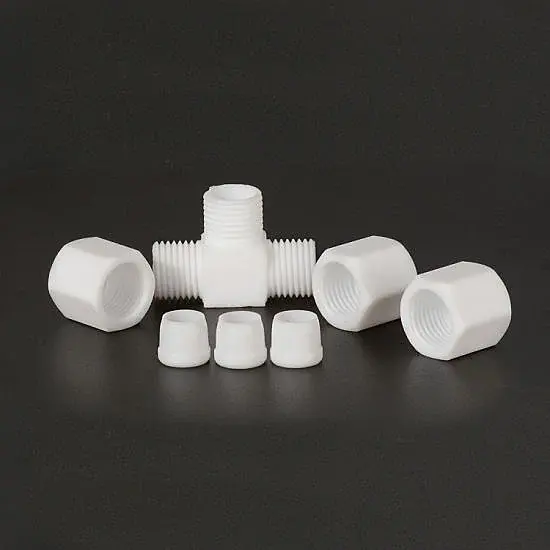Fittings aus Fluorkunststoffen, die in der Regel aus Materialien wie PTFE (Polytetrafluorethylen) und PFA (Perfluoralkoxy) hergestellt werden, sind spezielle Komponenten für Flüssigkeitssysteme, die ein hohes Maß an chemischer Beständigkeit, Reinheit und Temperaturtoleranz erfordern. Diese Fittings sind zum Verbinden, Steuern und Leiten von Flüssigkeitsströmen in verschiedenen Branchen vorgesehen.
CNC-Mechanisches Bauteil
Die CNC-Bearbeitung (Computer Numerical Control) ist ein subtraktives Fertigungsverfahren, bei dem computergesteuerte Maschinen Material von einem Werkstück abtragen, um präzise und komplexe Formen zu schaffen. Die CNC-Bearbeitung wird häufig für die Herstellung von Fittings aus Fluorkunststoffen verwendet und gewährleistet eine hohe Genauigkeit, Wiederholbarkeit und Konsistenz bei der Produktion dieser Komponenten.
PFA-Armaturen
PFA-Fittings bieten ähnliche Eigenschaften wie PTFE-Fittings, einschließlich ausgezeichneter chemischer Beständigkeit und Hochtemperaturtoleranz. Allerdings sind PFA-Fittings im Vergleich zu PTFE flexibler und dehnbarer, wodurch sie einfacher zu installieren und weniger anfällig für Risse sind. PFA-Fittings werden häufig in folgenden Anwendungen eingesetzt:
- Systeme für ultrareines Wasser
- Lebensmittel- und Getränkeverarbeitungsbetriebe
- Pharmazeutische Produktionsstätten
- Halbleiterproduktionsanlagen
PTFE-Fittings
PTFE-Fittings sind für ihre außergewöhnliche chemische Beständigkeit bekannt, die sie für den Umgang mit hochkorrosiven Flüssigkeiten geeignet macht. Sie zeichnen sich außerdem durch ihre Hochtemperaturtoleranz, ihren niedrigen Reibungskoeffizienten und ihre hervorragenden elektrischen Isolationseigenschaften aus. PTFE-Fittings werden üblicherweise in folgenden Anwendungen eingesetzt:
- Chemische Verarbeitungsbetriebe
- Pharmazeutische Produktionsstätten
- Halbleiterproduktionsanlagen
- Laborausstattung
Unterschiede zwischen PTFE- und PFA-Fittings
Obwohl sowohl PTFE- als auch PFA-Fittings eine ausgezeichnete chemische Beständigkeit und Hochtemperaturtoleranz aufweisen, gibt es einige wichtige Unterschiede zwischen diesen Materialien:
- Flexibilität: PFA-Fittings sind flexibler als PTFE-Fittings, wodurch sie leichter zu installieren und weniger anfällig für Risse sind.
- Temperaturbeständigkeit: PTFE-Fittings haben eine etwas höhere Temperaturbeständigkeit als PFA-Fittings, mit einer maximalen Dauergebrauchstemperatur von 260°C (500°F) im Vergleich zu 240°C (464°F) für PFA-Fittings.
- Kosten: PTFE-Fittings sind im Allgemeinen kostengünstiger als PFA-Fittings.
 +86-13752771911
+86-13752771911 E-mail:ptfetube@yozonetech.cn
E-mail:ptfetube@yozonetech.cn



